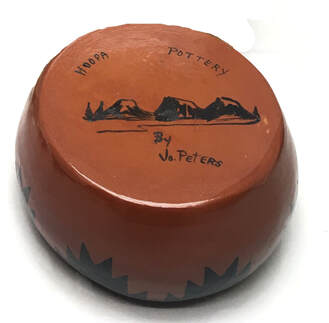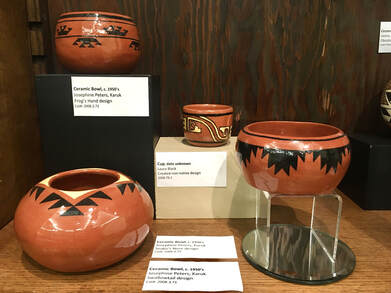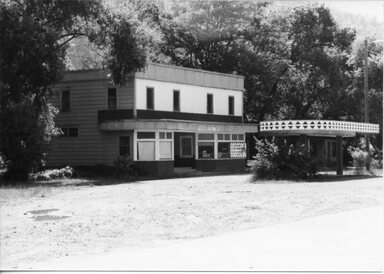Hoopa Pottery Guild:
blending new materials with old traditions
 Underside of pot by Josephine Peters, showcasing her signature marking noting Hoopa Pottery Guild made items.
Underside of pot by Josephine Peters, showcasing her signature marking noting Hoopa Pottery Guild made items.
Started in 1951, when Lura Black, a non-native field nurse working on the Hoopa Reservation, noticed sources of clay on her journeys to the valley. After Black introduced pottery-making process, she recruited other women from the valley into the endeavor. The Pottery Guild utilized sources of clay from the valley, and incorporated forms and designs from the basketry in the area.
“While local tribal people used baskets for all of their containers in the old days, basketry materials had become increasingly hard to obtain, and fewer and fewer women wove. According to Vivien Hailstone (Karuk/Yurok/member of the Hoopa Tribe), as quoted in a 1967 newspaper article, pottery filled the void.
“After the whites came in here, they tried to rule all of us - tell us what to do, and take things away from us, like weaving baskets. When we saw somebody coming, we’d hide it; just grab everything up and throw it behind a chair, or some other place, and cover it up with a towel...Well, after the government schools closed down, and everybody came back, most of the younger people had to learn the Indian ways all over again. A lot of them never did go back to it… Baskets were really dying out. Hardly anybody was making them anymore, because they had no [market] for it. They were scared to go out and sell it to someone, so we started making pottery” (After the First Full Moon in April: A Sourcebook of Herbal Medicine from a California Indian Elder, Beverly Ortiz & Josephine Peters, p. 51)
“While local tribal people used baskets for all of their containers in the old days, basketry materials had become increasingly hard to obtain, and fewer and fewer women wove. According to Vivien Hailstone (Karuk/Yurok/member of the Hoopa Tribe), as quoted in a 1967 newspaper article, pottery filled the void.
“After the whites came in here, they tried to rule all of us - tell us what to do, and take things away from us, like weaving baskets. When we saw somebody coming, we’d hide it; just grab everything up and throw it behind a chair, or some other place, and cover it up with a towel...Well, after the government schools closed down, and everybody came back, most of the younger people had to learn the Indian ways all over again. A lot of them never did go back to it… Baskets were really dying out. Hardly anybody was making them anymore, because they had no [market] for it. They were scared to go out and sell it to someone, so we started making pottery” (After the First Full Moon in April: A Sourcebook of Herbal Medicine from a California Indian Elder, Beverly Ortiz & Josephine Peters, p. 51)
 View of pottery pieces from Hoopa Pottery Guild on display at the Clarke Museum.
View of pottery pieces from Hoopa Pottery Guild on display at the Clarke Museum.
The Guild created beautiful pumpkin-orange vessels decorated with black, white, red, and yellow designs across the glossy surfaces. Much like weavers at the turn of the century, these potters used clay as a new material to record designs as they remembered them. Swallowtail, Frog’s Hand, Obsidian Blade designs and newer designs not bounded by counting sticks and more were painted on the pottery.
The group built a pottery studio in Hoopa near the main part of town, now near the Hoopa Tribal Office, it was lost in the 1964 flood, and in collaboration with community members, another was constructed in Hoopa on the Presbyterian Church grounds.
There were efforts early on in the formation of the group to merge pottery and basketry. At the Eureka Hobbies In Action fair in 1955 Lizzie Smith and Josephine Peters set up a booth for the Hoopa Pottery Guild. Showcasing their pottery ware while wearing their basket caps, were regarded as the most interesting booth at the fair.
The group built a pottery studio in Hoopa near the main part of town, now near the Hoopa Tribal Office, it was lost in the 1964 flood, and in collaboration with community members, another was constructed in Hoopa on the Presbyterian Church grounds.
There were efforts early on in the formation of the group to merge pottery and basketry. At the Eureka Hobbies In Action fair in 1955 Lizzie Smith and Josephine Peters set up a booth for the Hoopa Pottery Guild. Showcasing their pottery ware while wearing their basket caps, were regarded as the most interesting booth at the fair.
 Vivien's I-Ye-Quee Gift Shop. Hoopa Ca. late 1960's. (HSU Special Collections)
Vivien's I-Ye-Quee Gift Shop. Hoopa Ca. late 1960's. (HSU Special Collections)
Josephine Peters, one of the key members of the Pottery Guild had this to say on their endeavors: “We tried to save the basket designs by putting it on pottery. And then finally the weavers started coming back. We taught it in the school, we had evening gatherings, and we’d gather materials. I had people coming here to the house to sit down [and learn]...With the kids in school, we’d start out with maybe twenty to twenty-three students. When I ended up, I had two left, but the two that stuck with it, they’re really good weavers today. Some of them would come back [to it] later.”
Pottery in the valley continued past the dissolution of the guild in the 70’s-80’s when the building was taken back by the church. Potters instead set up home studios with kilns and other materials and set about taking in interested students as they saw fit. Examples of newer pottery items can be seen on display alongside older Hoopa Pottery Guild items such as a wonderful kingsnake design pot by Roger Masten and a wall plaque by Esther McCullough both of Hoopa.
Vivien Hailstone and Josephine Peters both set up storefronts in Hoopa- Vivien the I-Ye-Quee Gift Shop in 1959, and Josephine the Red Wing Indian Handicrafts in the late 1960's, where they both hosted basketry for sale by local weavers, and other crafts such as pottery and jewelry. Giving the local crafters a storefront to put their wares out there for the community and the small tourism trade.
Pottery in the valley continued past the dissolution of the guild in the 70’s-80’s when the building was taken back by the church. Potters instead set up home studios with kilns and other materials and set about taking in interested students as they saw fit. Examples of newer pottery items can be seen on display alongside older Hoopa Pottery Guild items such as a wonderful kingsnake design pot by Roger Masten and a wall plaque by Esther McCullough both of Hoopa.
Vivien Hailstone and Josephine Peters both set up storefronts in Hoopa- Vivien the I-Ye-Quee Gift Shop in 1959, and Josephine the Red Wing Indian Handicrafts in the late 1960's, where they both hosted basketry for sale by local weavers, and other crafts such as pottery and jewelry. Giving the local crafters a storefront to put their wares out there for the community and the small tourism trade.
